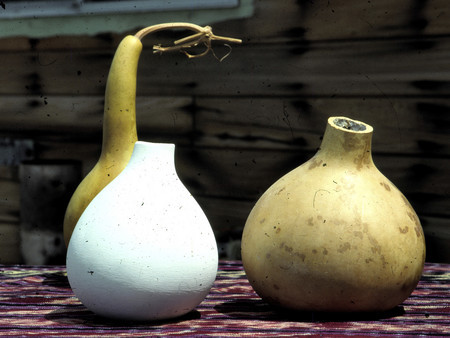Create your own Pueblo pots




Pueblo Indian pots start at $1,000 and can rise to six figures, according to "Antiques Roadshow" experts. I know I can never afford the real thing, but I can get the same look free or nearly free with gourds — and the proof sits all over my budget-decorated home.
The gourd preceded ceramics in the Americas as containers for food and water. In fact, gourds were the inspiration for the first pots, so there is a great deal of similarity in line and form between the two.
Gourds are essentially inedible winter squash with a hard shell and minimal flesh inside. They are easy to grow, if you have the space and the time. If you don’t want to wait, buy them in the fall at any local pumpkin patch. The seeds inside may be saved to plant in your own garden next year. There’s no guarantee of the outcome, but many turn out well.
Whether you grow or buy, there are many types from which to choose, including pots, dippers, canteens or warty gourds. Turning them into useful or decorative containers is the perfect "green" craft that lets you create truly remarkable works of art for little to no money. In fact, gourds can save you money because every finished pot can be another Christmas gift you don’t have to buy. Just imagine how much you’ll save with a whole crop of gourds grown from a $2 packet of seeds.
When buying at pumpkin patches, select a variety of different sizes and shapes so you’ll have lots to choose from during the long winter months. Look for those that stand up well without leaning.
The beauty of fully dry, cured gourds is that they have an outer surface that is easy to gouge, burn or paint. They also bounce when you drop them. The invention of the Dremel rotary tool literally revolutionized this craft, allowing you to create beautiful shapes, cutouts and textures with little effort. But for those on a smaller budget, a sharp heavy-blade paring knife, a hacksaw blade wrapped in duct tape for a handle or some sandpaper works just as well.
There are endless ways to decorate gourds to resemble the work of Southwestern Pueblo potters. A good resource online is the Gene Autry National Center, www.autrynational center.org, where you can search for Pueblo pottery and find photos of real antiques that provide lots of ideas for color, pattern and purpose.
There are two ways to get the best Indian-style pots. You can leave the gourd its natural color and use a simple wood-burning tool to carve your designs, or you can paint the surface any way you wish.
Wood-burners leave a depression where you make your line, and therefore the pattern will never wear off. Once your gourd pattern is incised, rub on a patina made of watered-down craft paint, wood stain or leather dye to give it an aged look.
Create more detailed patterns with paint atop a sanded, prepared outer surface. The old Pueblo pots were white with more elaborate graphics painted on. The downside to paint is that it chips and gets dusty. A compatible clear sealer helps reduce both problems.
When it comes to the giant world of gourds, there are societies, growers and seed sellers all over the Internet. And if that isn’t enough to jump-start your creative juices, check out the work of the many gourd artists online.
With money short these days, few crafts offer so much beauty and interest for so little money. If you love American Indian artifacts or are seeking to create real Western-style décor in your house or porch, now is the time to start shopping for gourds.
These Web sites don’t just sell gourds; they also contain great illustrations and instructions on how to cure and prepare raw gourds for decorating: Welburn Gourd Farm, www.WelburnGourdFarm.com and Leiser Farms, www.GourdFarmer.com.
Maureen Gilmer is a horticulturist. Her blog, the MoZone, offers ideas for cash-strapped families. Read the blog at www.MoPlants.com/blog. E-mail her at mogilmer@yahoo.com. Also, join her online for the Garden Party social networking at Learn2grow.com.












